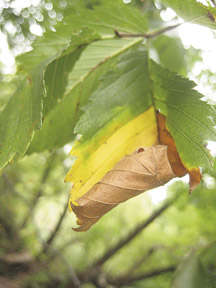Many people are disappointed that summer is over and cold weather is on the horizon. With fall having started last week, it’s an understandable reaction. However, enjoying the scenery of the leaves changing in the next few weeks may soften the blow.
James J. Braddock Park in North Bergen already has autumn palettes of yellow, orange, gold, red, and brown starting to take hold in their tree canopies.
Oaks tend to turn red or brown.
________
Chlorophyll is the chemical that gives leaves their normal green color and is necessary for photosynthesis, which enables plants to use sunlight to create sugar. During the summer, chlorophyll is constantly being produced and broken down, while in the fall, production slows down and then eventually stops.
Carotenoids and anthocyanins that are normally present in leaves are left as the dominant forces in leaf cells, and they make leaves turn a variety of colors.
Certain trees turn specific colors. Oaks turn red or brown.
Weather, sunshine, and soil can affect how long and how vivid leaves are.
So before the fall foliage has fallen, enjoy the colors.
Tricia Tirella may be reached at TriciaT@hudsonreporter.com.
